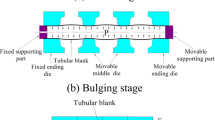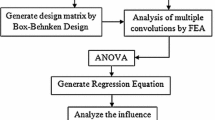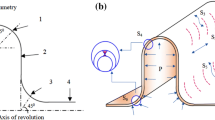Abstract
Forming process of the metal bellows is very sensitive to the fluctuation of material parameters. In this state, revealing the influence of material parameters on deformation behaviors is important for desirable dimension and mechanical performance. In this paper, the effects of the material parameters of 316L stainless steel on the bellow hydroforming process are studied by finite element analysis and Taguchi method. The most important factor influencing the final shape of convolution of the metal bellows is found out. Two multi-linear regressions between the quality responses and the material parameters are extracted and evaluated by simulated and experimental results. Based on the regression equations, response surfaces of the quality characteristic and the reasonable factor region for required forming quality are obtained. Further, the relationship between the internal pressure and the material parameters is built to guarantee the shape of the bellows. The method is applied in the scenario when the material is changed to AISI 304 steel, and a satisfying prediction profile is achieved.
















Similar content being viewed by others
References
Witzenmann GmbH (2010) Manual of metal bellows. Available from: https://www.witzenmann.com/mediapool/documents/metal-bellows-manual.pdf
Sedighi M, Shamsi M (2017) A new approach in producing metal bellows by local arc heating: a parametric study. Int J Adv Manuf Technol 93:3211–3219
Kang BH, Lee MY, Shon SM, Moon YH (2007) Forming various shapes of tubular bellows using a single-step hydroforming process. J Mater Process Technol 194:1–6
Ra JH, Han SW, VanTyne CJ, Moon YH (2019) Manufacturing of a wire reinforced aluminum tube via hydroforming process. Int J Mach Tool Manu. https://doi.org/10.1016/j.ijmachtools.2019.05.0015
Koç M, Aue-u-lan Y, Altan T (2001) On the characteristics of tubular materials for hydroforming - experimentation and analysis. Int J Mach Tools Manuf 41(5):761–772
Zribi T, Khalfallah A, BelHadjSalah H (2013) Experimental characterization and inverse constitutive parameters identification of tubular materials for tube hydroforming process. Mater Design 49:866–877
Yingyot AUL, Gracious N, Taylan A (2004) Optimizing tube hydroforming using process simulation and experimental verification. J Mater Process Technol 146:137–143
Carleer B, Kevie G, Winter L, Veldhuizen B (2000) Analysis of the effect of material properties on the hydroforming process of tubes. J Mater Process Technol 104:158–166
Fatemi A, Morovvati MR, Biglari FR (2013) The effect of tube material, microstructure, and heat treatment on process responses of tube hydroforming without axial force. Int J Adv Manuf Technol 68:263–276
Manabe K, Amino M (2002) Effects of process parameters and material properties on deformation process in tube hydroforming. J Mater Process Technol 123:285–291
Koc M (2003) Investigation of the effect of loading path and variation in material properties on robustness of the tube hydroforming process. J Mater Process Technol 133:279–281
Xu XH, Li SH, Zhang WG, Lin ZQ (2009) Analysis of thickness distribution of square-sectional hydroformed parts. J Mater Process Technol 209:158–164
Kim S, Kim Y (2002) Analytical study for tube hydroforming. J Mater Process Technol 128:232–239
Zadeh HK, Mashhadi MM (2006) Finite element simulation and experiment in tube hydroforming of unequal T shapes. J Mater Process Technol 177:684–687
Ahmadi H, Zohoor M (2017) Investigation of the effective parameters in tube hydroforming process by using experimental and finite element method for manufacturing of tee joint products. Int J Adv Manuf Technol 93:393–405
Faraji G, Mashhadi MM, Norouzifard V (2009) Evaluation of effective parameters in metal bellows forming process. J Mater Process Technol 209:3431–3437
Hao ZL, Luo SY, Zhao H, Zhang CX, Luo JT (2017) Effect of plate hardening behavior on the deformation of stainless steel metal bellows. J Mater Eng Perform 26(11):5385–5395
Kamaruddin S, Khan ZA, Foong SH (2010) Application of Taguchi method in the optimization of injection moulding parameters for manufacturing products from plastic blend. Int J Eng Technol 2:574–580
Roy R (1990) A primer on the Taguchi method, 2nd edn. Society of Manufacturing Engineers, Dearborn, pp 14–18
Reddy P, Reddyb B, Rao P (2018) A numerical study on tube hydroforming process to optimize the process parameters by Taguchi method. Materials Today: Proceedings 5:25376–25381
Thipprakmas S, Phanitwong W (2011) Process parameter design of spring-back and spring-go in V-bending process using Taguchi technique. Mater Design 32:4430–4436
Li B, Nye TJ, Metzger D (2006) Multi-objective optimization of forming parameters for tube hydroforming process based on the Taguchi method. Int J Adv Manuf Technol 28:23–30
Lee SW (2002) Study on the forming parameters of the metal bellows. J Mater Process Technol 130-131:47–53
Liu J, Li HW, Liu Y, Li LY, Sun C (2018) “Size effect” related hydroforming characteristics of thin-walled 316-L bellow considering pressure change. Int J Adv Manuf Technol 98(1-4):505–522
Liu J, Lv ZY, Liu Y, Li LY (2020) Deformation behaviors of four-layered U-shaped metallic bellows in hydroforming. Chin J Aeronaut 33(12):3479–3494
Abaqus, I (2006) Configuring tangential behavior for connector friction. Available from: https://classes.engineering.wustl.edu/2009/spring/mase5513/abaqus/docs/v6.6/books/usi/default.htm?startat=pt03ch15s15hlb04.html
Adnan MF, Abdullah AB, Samad Z (2017) Springback behavior of AA6061 with non-uniform thickness section using Taguchi Method. Int J Adv Manuf Technol 89:2041–2052
Box G, Hunter J, Hunter W (2005) Statistics for experimenters: design, innovation, and discovery. Second edition. John Wiley & Sons, Inc
GB/T 12777-2008 (2008) General specification for metal bellows expansion joints: 10-14 [in Chinese]
Availability of data and materials
All data generated or analyzed during this study are included in this article.
Funding
The authors would like to thank the funds of the National Natural Science Foundation of China (No. 51875456), the Natural Science Basic Research Plan in Shaanxi Province of China (No. 2019JM-450), the Shaanxi Provincial Education Department (No.20JC029), the Key Laboratory of Advanced Manufacture Technology for Automobile Parts (Chongqing University of Technology), Ministry of Education (No. 2018KLMT03), and the Program for Young Innovative Research Team in Xi’an Shiyou University (No. 2015QNKYCXTD02).
Author information
Authors and Affiliations
Contributions
Methodology, Jing Liu and Yang Liu; validation, Lanyun Li and Jian Liu; formal analysis, Jing Liu, Yang Liu, Lanyun Li, and Jian Liu; investigation, Yang Liu and Jing Liu; writing (original draft preparation), Jing Liu; writing (review and editing), Jing Liu, Yang Liu, Lanyun Li, and Jian Liu; funding acquisition, Jing Liu. All authors have read and agreed to the published version of the manuscript.
Corresponding authors
Ethics declarations
Ethical approval
Not applicable.
Consent to participate
Not applicable.
Consent to publish
Not applicable.
Competing interests
The authors declare no competing interests.
Additional information
Publisher’s note
Springer Nature remains neutral with regard to jurisdictional claims in published maps and institutional affiliations.
Rights and permissions
About this article
Cite this article
Liu, J., Liu, Y., Li, L. et al. Numerical investigation of the effect of material properties on forming metal bellows. Int J Adv Manuf Technol 116, 2425–2436 (2021). https://doi.org/10.1007/s00170-021-07551-z
Received:
Accepted:
Published:
Issue Date:
DOI: https://doi.org/10.1007/s00170-021-07551-z




